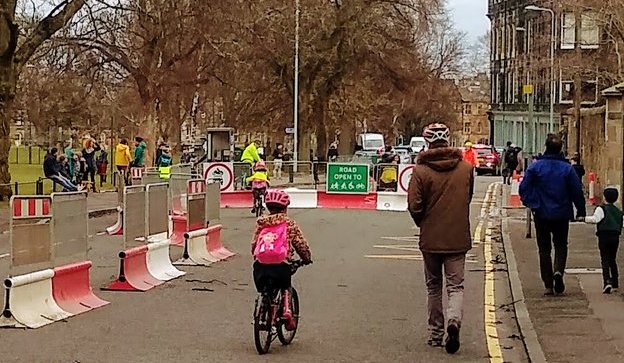Our Spaces for People – The Future meeting unexpectedly developed a strong theme of making streets safer for children, particularly after the input of our three local-area speakers. And that, of course, makes sense, because children are the future.

Summing up the meeting, our QA chair, Dr Caroline Brown, referenced former Bogota mayor Enrique Peñalosa, whose many inspirational quotes [more below*] include…
“Children are a kind of indicator species. If we can build a successful city for children, we will have a successful city for everyone.”
The meeting, lasting nearly 2 hours, was attended by 155 people of whom over 120 were still online by the summing up, showing great interest in Spaces for People and what happens next. The registration process showed that roughly half the audience were not Spokes members, and we were pleased that a good number (about 20%) had come along to find out more even though they were unsure or opposed to SfP – several of their questions were covered in the QA. The GoToWebinar software (kindly supplied by Cycling UK) told us that audience “interest” was 86%, a very high figure for webinars, and the post-meeting feedback survey [below] was full of positivity.
The webinar was recorded – you can see it at https://youtu.be/aAN17Vw9v_g. There’s also a detailed set of notes here. Below is a summary of the meeting – but see the recording and/or notes for a more comprehensive picture.
Intro – Dave du Feu, Spokes [slides]
- Spokes had joined the response to the covid pandemic, with bike support for key workers
- The Spaces for People programme is a Scottish Government covid response, with £39m allocated to councils for this purpose (rest of UK did similar)
- From early on, the Minister, MSPs and Councils have said they would like to see successful SfP schemes made permanent, as such schemes contribute to other policies including on emissions, congestion and public health
- Making schemes permanent will require much time for consultation, detailed design, traffic orders; and significant government cash over the next 2-3 years
- It is ironic that far greater changes have been made to life on our streets, with zero consultation, through massive growth in the number and size of cars, now SUVs – and satnavs creating residential rat-runs.
Edinburgh Spaces for People: moving forward – Cllr Lesley Macinnes, Transport Convener [slides]
- Edinburgh successfully bid for over £5m of the government’s £39m funding
- Schemes had to be implemented quickly to get maximum impact during the pandemic
- Huge number of schemes in just one year (and more underway): Local town centres footway widening, traffic signals auto pedestrian phase, 40km main road segregated cycleroutes, 29 road closures/ access restrictions near schools, other measures at 54 more schools
- If schemes are made permanent, they will look different: long-lasting materials, fuller segregation, designs adapted on basis of experience
- If made permanent they will contribute to wider Council policies – Mobility Plan, City Centre Transformation, Active Travel Action Plan (to be revised this year), etc – to improve quality of life and reduce emissions
- Council now consulting widely on what to make permanent, or to experiment further – results coming to June Transport Cttee, along with result of independently conducted representative population survey
- To make permanent will then require Traffic Regulation Orders with detailed consultation and opportunity for objections on every scheme
- There is a huge amount of misinformation around, but Council is confident in its current policy and legal processes.
Edinburgh Spaces for People: moving forward – Phil Noble, council officer
- Safer cycling had been essential to give people an alternative to bus, with its covid risks, and running on reduced timetables
- Hence SfP cycle lanes on main roads, and where possible linking up routes, e.g. Comiston Rd – Greenbank/Meadows quiet route – Meadows/CityCentre
- Schools distancing measures at gates and approaches to school
- Spaces for exercise e.g. Silverknowes; Cammo Rd (with Maybury Rd crossing)
- Early feedback very positive from families & from people who cycle; but a lot of other people unhappy
- Report to June Transport Cttee will assess projects on a range of criteria including walk/cycle usage, impacts positive and negative on public transport, local businesses (loading and parking), traffic rat-runs, disabled access, and more.
Local comment – Jocelyn Dellar, Spokes Porty
- Duddingston Rd area has 2 primary, 2 secondary schools and a skatepark – many kids constantly using this road
- The SfP cycle lane & other measures now make it feel safe to cycle; pavement cycling reduced; cars travel slower due to narrower roadspace
- Overall the space is more fairly divided, reducing conflicts, despite more people walking & cycling
- Future – needs redesign to end the (much reduced) antisocial parking on footways and cycle lanes; redesign the junctions and install bike segregation on other side of road
Local comment – Claire Connachan, Corstorphine
- Big improvements for pedestrians in Corstorphine High Street area – wider footways, road closures
- Lower traffic speeds make cycling feel a lot safer
- Good to see more children walk & cycle – they are “indicator species” – if they are safe on the roads, so is everyone
- Future – biggest cycling issue is need for segregated cycleroute on the A8 – why has this not been in SfP?
Local comment – Ewen Maclean, Blackford Safe Routes [pictures]
- Meadows-Greenbank quiet route (involving modal filters = road closures) has been very beneficial
- Many more children walking, cycling, scooting etc to school
- Reduced car presence makes the area quieter, safer, friendlier; yet drivers can still access every destination
- Future – if not made permanent we are removing safety and the chance to walk or cycle from these kids
- Future – learn from this experience and set up trials in surrounding areas, whilst ensuring no rat runs
QA session, chaired by Dr Caroline Brown of The Urban Institute, Heriot-Watt University
With behind-the-scenes assistance from Martin McDonnell, the 60 or so questions received during the evening (and a few received in advance) were cleverly combined by Caroline into themes as below, each theme covering several questions (with questioners’ names mentioned) so that a good proportion of the questions were discussed. The themes are below. For the answers, either watch the recording or, for a summary, check out our note-taker’s report (be aware that these are notes, not verbatim, so to quote anything use the recording)
- What decides which areas get SfP measures? e.g. why not Kaimes, Colinton, Balerno?
- What criteria were used for SfP design? e.g. type of bollards, cycle lane width, maintenance
- Why do designs still allow some illegal parking? What enforcement is there?
- Is trade being killed where SfP measures reduce or prevent loading/parking outside shops?
- What are the assessment criteria for the June report on making SfP schemes permanent?
- How are disabled people affected by SfP measures?
- Why are there few SfP measures at junctions, when these are main danger areas?
- How do we use social media to reinforce positive messages and counter negativity?
Meeting summary by Caroline
Very impressive progress has been made with SfP in Edinburgh in a short period of time. We take our hats off to the Council for embracing this and for their achievements to date. Lots of learning has also been taking place. Now a period of reflection is coming, with the consultation, and we wish them well with this.
Meantime, this week Scottish Government has backed the UN Convention of the Rights of the Child (UNCRC) and become the first devolved nation in the world to incorporate it into its domestic law. This signals a culture shift with great potential to transform children’s lives in Scotland, as it enshrines their right to be heard, to be safe and protected, and to participate – with reporting obligations and funding to implement.
We have heard how they should be regarded as an indicator species when it comes to cycling: as Enrique Peñalosa said, a good city is a city where children can ride their bikes safely. Lets bring it on!
Thank-you and what’s next?
- Many thanks to Cycling UK for use of and superb support with the GoToWebinar software
- Many thanks to all our speakers, organisers, attendees – and you the reader!
- Please respond to the Council SfP consultation – closes 5 April
- Please retweet our tweet about this article.
- April 15 – Spokes hustings, for the May 6 Scottish Parliament election, Lothians area – there will shortly be a website article on this, together with links to all-Scotland events and information from Walk Wheel Cycle Vote, Cycling UK Scotland, and others
- Spokes Competition – Cycling in the Pandemic Website article soon. Your experience, or an interesting incident – a story, photo, video, whatever. Great prizes including bike shop vouchers, maps, buffs and vouchers towards buying a cargo bike or ebike
Meeting resources
- Full recording of the meeting
- Note-taker’s report
- Pre-meeting website article and tweet
- Slides used by Dave du Feu
- Slides used by Cllr Macinnes
- Pictures used by Ewen Maclean
- Audience feedback report
- Tweet of this article (please retweet!)
*Quotes by Enrique Peñalosa include…
- Children are a kind of indicator species. If we can build a successful city for children, we will have a successful city for everyone
- An advanced city is not one where even the poor use cars, but rather one where even the rich use public transport
- A bikeway is a symbol that shows that a citizen on a $30 bicycle is equally important as a citizen on a $30,000 car
- The essence of the conflict today, really, is cars versus people…We can have a city that is very friendly to cars, or a city that is very friendly to people. We cannot have both
- Urban transport is a political and not a technical issue. The technical aspects are very simple. The difficult decisions relate to who is going to benefit from the models adopted
- More at www.azquotes.com/author/52989-Enrique_Penalosa

space for school – @blackfordsafer1 
space for cycling – @johnrobson87 
space for queuing – @porthkea 
space for playing – @justacwab








